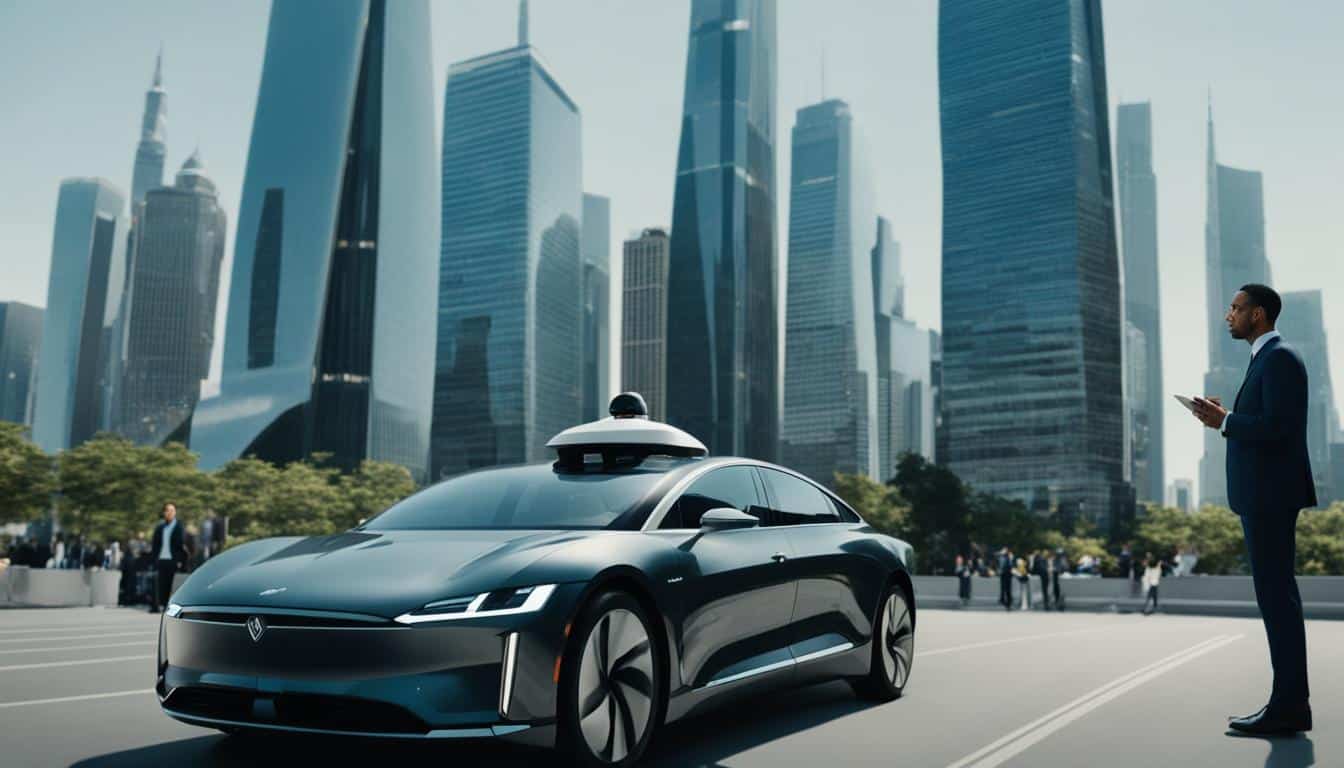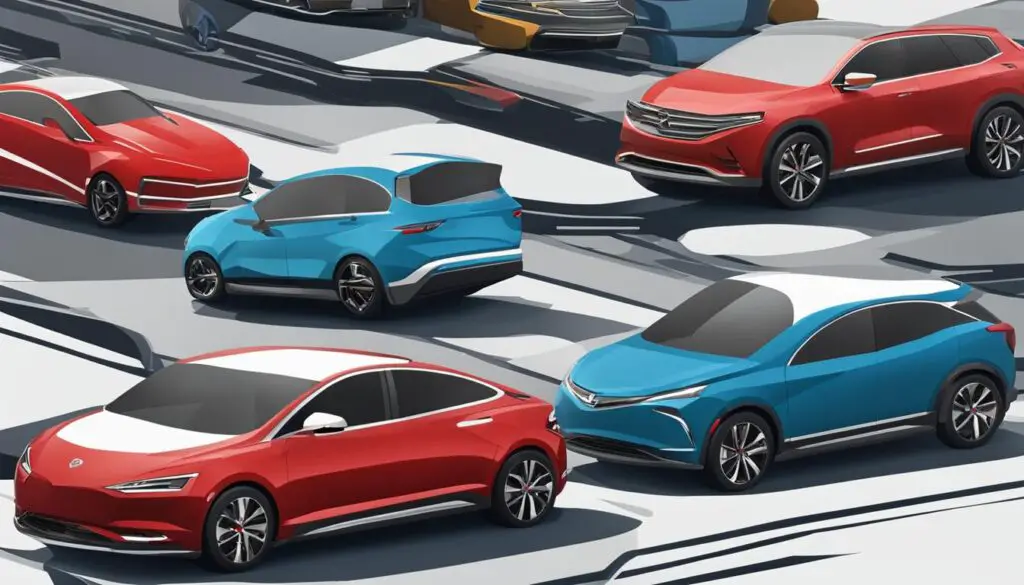
How Self-Driving Cars are Reshaping the Insurance Industry
Self-driving cars are not only revolutionizing transportation but also transforming the insurance industry. The impact of these autonomous vehicles on risk assessment, policy rates, and overall industry dynamics is significant.
The advancement of self-driving technology has the potential to eliminate the need for approximately 380,000 long-haul truck drivers in the next five years. This widespread adoption of autonomous vehicles could lead to a shift in premiums across multiple insurance lines, such as commercial auto, product and professional liability, and cyber coverage. The insurance industry is facing the challenge of adapting to this technological disruption and reevaluating traditional risk assessment models.
Key Takeaways:
- Self-driving cars are revolutionizing the insurance industry.
- The elimination of human drivers could lead to a shift in premiums across different insurance lines.
- Insurance companies need to adapt their risk assessment models to account for the reduced risk associated with autonomous vehicles.
- The integration of telematics and big data analytics allows insurers to offer personalized coverage based on real-time vehicle performance.
- Determining liability in accidents involving autonomous vehicles requires clear regulations and standardized procedures.
The Impact of Autonomous Trucks on the Insurance Industry
The shortage of human truck drivers in the United States is a significant factor driving the growth of autonomous trucks. With the American Trucking Association reporting a driver shortage of 78,000, the industry is in need of new solutions.
Autonomous trucks not only have the potential to alleviate this shortage but also offer increased efficiency and fuel savings.
This shift towards autonomous trucks could have a significant impact on the commercial auto insurance market, reducing accident frequency and potentially changing the line of liability coverage.
Reduction in Accidents
One of the most promising aspects of autonomous trucks is the potential to reduce accidents on the road. Human error is a leading cause of accidents, and by eliminating the need for human drivers, autonomous trucks can help mitigate this risk. With advanced sensors, artificial intelligence, and real-time data analysis, autonomous trucks can make more accurate decisions and respond quickly to changing road conditions.
According to the National Highway Traffic Safety Administration, 94% of accidents are caused by human error. By removing humans from the equation, autonomous trucks have the potential to significantly reduce the number of accidents on the road.
Impact on Commercial Auto Insurance
The reduction in accidents associated with autonomous trucks can have a profound effect on the commercial auto insurance industry. With fewer accidents, insurers will see a decrease in claims, leading to lower payouts and potentially lower premiums for policyholders.
Furthermore, the shift towards autonomous trucks may also change the line of liability coverage. Currently, the driver is typically held responsible for accidents. However, with autonomous trucks, the responsibility may shift to the truck manufacturer, software developers, or other parties involved in the production and maintenance of the autonomous systems.
| Impact of Autonomous Trucks on Commercial Auto Insurance | Potential Changes |
|---|---|
| Reduction in accident frequency | Lower claims and potentially lower premiums |
| Shifting liability | Redefining the line of coverage |
The exact impact on insurance premiums and policy structures will depend on the development and implementation of autonomous truck technology as well as regulatory frameworks surrounding liability. However, it is clear that the insurance industry will need to adapt to the growing presence of autonomous trucks and the changes they bring to the risk landscape.
Redefining Risk Assessment for Self-Driving Cars
Self-driving cars have the potential to revolutionize the way we assess risk in the insurance industry. With over 90% of accidents attributed to human error, the introduction of autonomous vehicles could significantly reduce traffic accidents and reshape the risk landscape.
However, this shift poses a unique challenge for insurance companies. Traditional auto insurance models heavily rely on factors such as driving history and human error to determine policy rates. With the reduced human error associated with self-driving cars, insurers will need to adapt their risk assessment models to accurately reflect the new risk profile.
Instead of focusing solely on driving history, insurers will need to place greater emphasis on the reliability of autonomous systems and manufacturers’ track records. This means evaluating the technology behind self-driving cars and the overall reputation of the companies producing them. By doing so, insurers can better assess the reduced risk associated with self-driving cars and adjust their insurance models accordingly.
Implementing accurate risk assessment models for self-driving cars is crucial for both insurance companies and consumers. Insurers need to ensure that policy rates align with the actual risk presented by autonomous vehicles, providing fair and affordable coverage. At the same time, consumers can benefit from reduced insurance premiums as a result of the lower risk.
Adapting risk assessment models to incorporate self-driving car technology requires a comprehensive understanding of the autonomous systems and their capabilities. Insurers must stay up-to-date with the latest advancements and industry standards to accurately gauge the level of risk associated with different autonomous vehicles and manufacturers.
Benefits of Redefined Risk Assessment:
- More accurate representation of the risk profile for self-driving cars
- Potential for lower insurance premiums for consumers
- Fair and affordable coverage for autonomous vehicle owners
- Encouragement of technological innovation and adoption of self-driving cars
By redefining risk assessment models, insurance companies can effectively adapt to the rise of self-driving cars and ensure that both insurers and consumers are adequately protected in this new era of transportation.
| Traditional Risk Assessment Model | Redefining Risk Assessment for Self-Driving Cars |
|---|---|
| Emphasizes driving history and human error | Focuses on the reliability of autonomous systems and manufacturers’ track records |
| Higher premiums due to human error risk | Potential for lower premiums with reduced human error |
| Relies on past data and statistics | Requires ongoing evaluation of autonomous technology and industry standards |
Leveraging Data for Improved Insurance Coverage
The integration of telematics and big data analytics becomes crucial in the era of self-driving cars. These vehicles generate a vast amount of data, which can be leveraged by insurers to gain insights into driving patterns, vehicle performance, and overall risk profiles. Proactive risk management allows insurers to offer more personalized and dynamic coverage, aligning premiums with the real-time performance of autonomous vehicles.
Telematics, the use of GPS and onboard diagnostics, enables the collection of valuable data about self-driving cars. Driving patterns such as speed, acceleration, and braking can be analyzed to assess risk levels accurately. Furthermore, telematics can provide real-time data on vehicle health, maintenance needs, and potential failures, ensuring timely preventive measures.
“Telematics revolutionizes how insurers assess risk for self-driving cars. By monitoring real-time data, we can proactively manage risk, enabling personalized coverage options for drivers.”
Insurers employing big data analytics can harness the power of this vast pool of information. Advanced analytics algorithms can process and analyze data from numerous sources, including telematics devices, traffic patterns, weather conditions, and driver behavior. This enables insurers to identify hidden patterns, uncover emerging risks, and develop predictive models for more accurate risk assessment.
By moving from reactive to proactive risk management, insurers can better anticipate and prevent potential accidents or hazards. This shift allows them to offer tailored coverage that aligns with the real-time performance of self-driving cars. For example, if an autonomous vehicle consistently demonstrates safe driving behavior, insurers may offer lower premiums or additional benefits.
Benefits of Leveraging Data in Insurance Coverage
By leveraging data from self-driving cars, insurers can provide the following benefits:
- Personalized coverage: Tailored policies that consider individual driving patterns and risk profiles.
- Dynamic premiums: Real-time adjustment of premiums based on driving performance, encouraging safer behavior.
- Accurate risk assessment: Data-driven insights that enhance underwriting and pricing models for self-driving cars.
- Improved claims processing: Quick and accurate assessment of accidents and claims, reducing fraudulent activities.
Insurers that embrace data analytics can gain a competitive edge in managing the risks associated with self-driving cars. These insights enable insurers to develop innovative and flexible coverage options that meet the evolving needs of autonomous vehicle owners and operators.
| Data Source | Insights |
|---|---|
| Telematics devices | Real-time driving behavior, vehicle performance, maintenance needs |
| Traffic patterns | Identifying potential accident hotspots and congestion |
| Weather conditions | Assessing risks associated with adverse weather |
| Driver behavior | Identifying trends and risks related to human override activities |
With the combination of telematics and big data analytics, insurers can proactively manage risks, enhance coverage, and adapt to the changing landscape of self-driving cars.
Navigating Liability in Autonomous Accidents
Determining liability in accidents involving self-driving cars presents complex legal and insurance challenges. With the rise of autonomous vehicles, fault attribution requires a deep understanding of the technology and potential malfunctions. Insurance companies find themselves navigating intricate legal battles to ascertain responsibility, as this greatly influences the design of insurance policies.
To successfully navigate the evolving landscape of liability in autonomous accidents, clear regulations and standardized procedures are necessary. These guidelines will help establish a consistent framework for determining fault and allocating liability in cases involving self-driving cars. The development of comprehensive rules and regulations is crucial to ensure fairness in the event of accidents or incidents caused by autonomous vehicles.
“Navigating the intricate legal and insurance landscape of autonomous accidents requires a delicate balance between technological understanding and legal expertise. Clear regulations and standardized procedures are essential to ensure fair and just outcomes for all parties involved.”

Challenges in Autonomous Accidents Liability
Liability in self-driving car accidents is multifaceted due to the complex interactions between humans, technology, and the environment. Some of the key challenges include:
- The transition from human error to technology malfunction as the primary cause of accidents
- Determining the level of human control or intervention required for holding drivers responsible in autonomous vehicles
- The liability of car manufacturers, software developers, and other parties involved in the creation and maintenance of self-driving technology
- The potential impact of external factors such as road conditions, weather, and infrastructure on accident liability
The Role of Insurance Policies
Insurance policies play a pivotal role in the liability landscape of self-driving cars. As the technology evolves, insurance companies are adapting their policies to address the unique risks and challenges associated with autonomous vehicles. These policies may include:
- Product liability coverage for autonomous vehicle manufacturers
- Technology errors and omissions policies for software developers and system integrators
- Commercial auto policies that consider the various levels of autonomous capabilities in vehicles
- Additional coverage options to account for cyber risks and potential hacking vulnerabilities
“The insurance industry is actively responding to the challenges of liability in autonomous accidents. With the right policies, both consumers and businesses can have the peace of mind they need to embrace self-driving technology.”
Comparative Liability in Autonomous Accidents
| Liability Factors | Traditional Accidents | Autonomous Accidents |
|---|---|---|
| Primary Cause | Human Error | Technology Malfunction |
| Driver Responsibility | Human Driver | Shared Responsibility |
| Manufacturer Liability | Minimal | Significant |
| External Factors Impact | Considered | Evaluated |
Shifting Premiums and Policies in the Autonomous Insurance Landscape
The rise of self-driving cars is set to revolutionize the insurance industry and reshape the economic landscape of insurance premiums. While the adoption of autonomous vehicles may lead to a decrease in the frequency of accidents, there are new factors that will influence insurance policies and rates. In this section, we will explore how advancements in technology, repairs, and the reliability of self-driving cars will impact insurance premiums.
Technology and Insurance Premiums
As self-driving cars become more prevalent on the roads, the technology onboard these vehicles will play a significant role in determining insurance premiums. Insurance providers will likely assess the autonomous systems’ capability to reduce the risk of accidents and their ability to prevent collisions caused by human error. The presence of advanced safety features and robust autonomous technology will be key considerations in insurance underwriting, with vehicles equipped with the latest technology potentially enjoying lower premiums.
Repairs and Insurance Costs
While self-driving cars may reduce accident frequency, they introduce a new challenge in terms of repairs. The cutting-edge technology and intricate systems of autonomous vehicles may significantly drive up repair costs. Specialized technicians and unique replacement parts will be essential for servicing these vehicles, resulting in higher repair bills. As insurance companies anticipate these increased costs, it is plausible for insurance premiums to reflect the expenses associated with repairing autonomous technology.
Reliability and Insurance Policies
The reliability of self-driving cars and the track record of their manufacturers will be crucial factors influencing insurance policies. Insurance providers will closely evaluate the reputations, safety records, and reliability of autonomous vehicle manufacturers. Companies with a track record of producing reliable and safe self-driving technology may enjoy more favorable policy terms and potentially lower premiums. On the other hand, manufacturers with reliability issues may face increased scrutiny and higher insurance costs.
Insurance premiums will become closely tied to the technology onboard the vehicle, the manufacturer’s reputation, and the overall reliability of the autonomous system.
As insurers navigate the evolving landscape of self-driving cars, the development of new policies and pricing models will be essential to accurately reflect and manage the emerging risks. Insurance companies that successfully recalibrate their pricing strategies based on the technology, repairs, and reliability aspects of autonomous vehicles will be well-positioned to provide comprehensive coverage at competitive rates. By analyzing data, insurers can adapt their policies and premiums to reflect the changing dynamics of the autonomous insurance landscape.

Conclusion
As self-driving cars revolutionize the automotive industry, the insurance industry faces both challenges and opportunities. Insurers must navigate the complexities brought by autonomous technology, legal frameworks, and evolving economic paradigms to ensure a secure journey for all.
The emergence of self-driving cars presents challenges for insurance companies in terms of risk assessment and liability attribution. Traditional insurance models relying on driving history and human error will need to be adapted to account for reduced risk and liabilities associated with autonomous vehicles.
Despite these challenges, the rise of self-driving cars also brings opportunities for insurers. The integration of telematics and big data analytics allows insurers to leverage data to gain valuable insights into driving behavior, vehicle performance, and risk profiles. This shift from reactive to proactive risk management enables insurers to offer more personalized and dynamic coverage.
In this changing landscape, the ability to adapt and evolve will be key for the insurance industry. Insurers that can successfully navigate the complexities and develop diverse product offerings will be well-positioned to thrive in the era of self-driving cars.
FAQ
How will the advancement of self-driving technology impact the insurance industry?
The advancement of self-driving technology has the potential to reshape the insurance industry by revolutionizing risk assessment and policy rates.
What is the potential impact of autonomous trucks on the insurance industry?
Autonomous trucks can have a significant impact on the insurance industry, especially in the area of commercial auto insurance, by reducing accidents and addressing the driver shortage.
How will the risk assessment models in the insurance industry change with the rise of self-driving cars?
The insurance industry will need to reevaluate its risk assessment models to account for the reduced risk associated with self-driving cars and focus on the reliability of autonomous systems and manufacturers’ track records.
How can telematics and big data analytics be leveraged in the era of self-driving cars?
Insurers can utilize telematics and big data analytics to gain insights into driving patterns, vehicle performance, and overall risk profiles. This allows for more personalized and dynamic coverage based on the real-time performance of autonomous vehicles.
What challenges do insurance companies face in determining liability in accidents involving autonomous vehicles?
Determining liability in autonomous accidents presents legal and insurance challenges as it requires a deep understanding of the technology and potential malfunctions. Insurance policies may need to be redesigned, and clear regulations and standardized procedures are necessary.
How will the rise of self-driving cars impact insurance premiums?
The rise of self-driving cars will reshape the economic landscape of insurance premiums. While the frequency of accidents may decrease, costs associated with repairing cutting-edge autonomous technology may offset these reductions. Insurance premiums will be closely tied to the technology onboard the vehicle, the manufacturer’s reputation, and the overall reliability of the autonomous system.
What are the challenges and opportunities for the insurance industry in the era of self-driving cars?
The insurance industry is faced with unprecedented challenges and opportunities in the era of self-driving cars. Adapting to the evolving mobility ecosystem and developing diverse product offerings will be key to thriving in this changing landscape.
Source Links
- https://www.aaxel.ca/the-world-with-self-driving-cars-and-its-impact-on-insurance/
- https://www2.deloitte.com/cz/en/pages/consumer-and-industrial-products/articles/autonomni-dopravni-prostredky-a-pojistovnictvi.html
- https://www2.deloitte.com/xe/en/insights/industry/financial-services/financial-services-industry-predictions/2023/fsi-autonomous-vehicle-insurance-predictions.html
